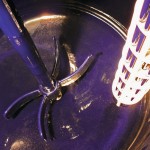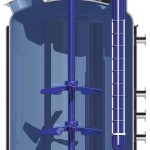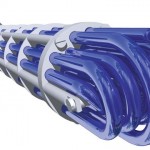Mixing processes, with their manifold conditions and constraints, require the use of baffles to optimise the mixing action. The desire of the operator is to make these processes more effective and more efficient while continuously increasing the processing flexibility of the reactors, for example in multi-component systems. A baffle in the form of a glass-lined tubular heat exchanger built into the mixing vessel helps to meet these demands.
The author: Dr. Jürgen Reinemuth Managing Director, Thaletec
The Powerbaffle is a baffle made of glass-lined U-tubes arranged close together. This guarantees high turbulence and high flow rates around the tubes and thus good thermal transfer.
The broad cross-section of the tube bundle brakes the fluid driven by the stirrer and produces the stirring function and/or change in flow direction that are so important for the mixing process. In a patented process, the U-tubes are shrunk into the tube bottom, to which they are connected without sealing, so as to be gas and fluid-tight. The question of the chemical resistance of the sealing elements thus does not arise: there are simply no additional elements that could cause potential problems.
Rapid heat transport
Powerbaffles have meanwhile been used successfully for some time by customers worldwide in different designs and sizes for mixing vessels from 630 to 40,000 l. The main applications so far have been operations that depend on optimal temperature control in the reactor or where a lot of heat must be supplied or dissipated within a short time.
A broad range of applications exists in polymerisation processes, for example: the optimal surface properties of the enamel effectively prevent the adhesion of polymers. The ease of cleaning the glass-lined surfaces guarantees long-lasting high efficiency of the baffle in the process. The additional heat exchange surface in the tank improves the heat dissipation in the exothermic polymerisation to such an extent that users have reported a productivity increase of up to 50 % compared to the original method, with an otherwise unchanged system configuration. From the point of view of the mixing technology, a Powerbaffle behaves like a conventional baffle, i.e. the baffle that would normally be built into the mixing vessel can be omitted and simply replaced with a Powerbaffle. The interference effects, and hence the power input during stirring, are almost identical to when conventional baffles are used.
The Powerbaffle is equipped with a Flexsens 100 temperature probe. To this end, the sensor is inserted into one of the heat exchanger tubes. The baffle is mounted in the mixing vessel in such a way that the flow passes directly over the temperature probe, preventing any impact on the measurement by the heated or cooled glass-lined U-tubes. The inserted Pt100 sensors can be removed for easy calibration.
The temperature sensor is positioned so that it takes measurements at the lowest possible point in the mixing vessel. Thus, even small volumes can be reliably detected and the temperature of residual quantities in the mixing vessel determined. In other words, the Powerbaffle combines the functions of a normal baffle, a temperature probe and a heat exchanger in a single component and as a result occupies only one vessel nozzle. It is dimensioned for mounting in the baffle nozzle of a mixing vessel and can also be easily retrofitted to existing equipment.
High thermal transfer coefficient
Heat transfer coefficients of up to 800 W/m2K can be achieved with the glass-lined Powerbaffle. If the heat transfer coefficient of a glass-lined mixing vessel is compared with the k-value of the glass-lined baffle, a value up to three times higher is obtained with a Powerbaffle than without. This means that one square metre of the Powerbaffle’s exchange area is equivalent to an exchange area of three square metres on the wall of the mixing vessel.
The flow conditions and the media in the product space and tubes have been disregarded in this calculation. An even greater improvement in thermal transfer can be achieved by selecting a suitable stirring system that is specially adapted to the process.
Online-Info: www.cpp-net.com/2211404
Share:









